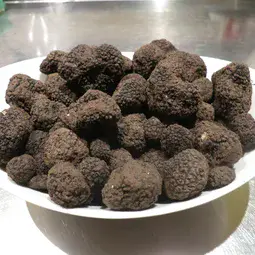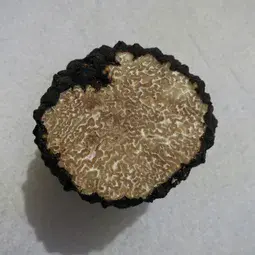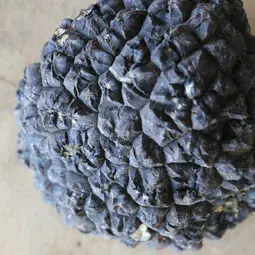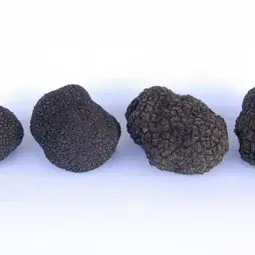Screening truffles for radioactivity 30 years from Chernobyl
Some forest mushrooms, such as wild porcini, can accumulate dangerous levels of radioactivity from the soils they grow in. But until now it was unclear if the same was true for truffles, fungi that range among the most expensive foods in the world. Swiss and German researchers have analysed Burgundy truffles collected in central Europe and found they contain only negligible amounts of radioactive caesium, being safe for consumption. The results are published today (25 February) in Biogeosciences, an open access journal of the European Geosciences Union (EGU).
The 1986 Chernobyl nuclear disaster in Ukraine released substantial quantities of radioactive particles, especially caesium-137 (137Cs). Transported by winds and deposited by heavy rainfall, the caesium polluted large swaths of the European continent. “Much of the continent’s topsoil layers are still radioactively contaminated,” says Ulf Büntgen, Head of the Dendroecology Group at the Swiss Federal Research Institute (WSL) and lead author of the study.
That, however, does not seem to affect the subterranean Burgundy or summer truffles (Tuber aestivum), which are highly prized as a delicacy for their hazel-nutty flavour and intense aroma. “We were very positively surprised that all specimens we analysed exhibited insignificant values of 137Cs,” says Büntgen.
This result is surprising because many types of fungi, including truffles, grow underground in – and draw nutrients from – soil prone to accumulating radioactive pollution. Deer truffles, for example, a type of ‘false’ truffles (not of the Tuber genus) more appealing to deer or wild boar than to humans, range among the most contaminated fungi. The team says that in regions where the radioactive fallout after Chernobyl was most intense, not only mushrooms but also higher components in the food chain, including game meat of red deer and wild boar, still have excess values of 137Cs.
The researchers wanted to be sure that wasn’t the case for summer truffles. “The main reason for our focus on the Burgundy truffle is the species’ wide ecological and thus geographical distribution, which allows us to compile fruit bodies over a wide range of environments. Growth of the Périgord black truffle, in contrast, is restricted to Mediterranean habitats only,” says Büntgen.
The researchers analysed 82 Burgundy truffles collected across Europe between 2010 and 2014. The samples were harvested by trained truffle dogs in several natural habitats and plantations in Switzerland, Germany, France, Italy and Hungary.
All samples had negligible radioactivity, the researchers report in Biogeosciences, with 137Cs values ranging below the detection limit of 2 becquerels per kilogram. This is far below the tolerance value of 600 becquerels per kilogram, meaning the truffles are safe for consumption, at least in the areas the researchers sampled from.
“Sampling sites were defined by the success of various truffle dogs. We were trying to get as many fruit bodies as possible from as wide an area as possible,” explains Büntgen. “The resulting pattern is by far not optimal but indeed good enough for a first assessment and interpretation.”
The researchers are unsure how their results would change if they had collected samples in areas with even higher 137Cs deposition, such as parts of Belarus or central Austria. “We really don’t know,” Büntgen acknowledges. “We will, however, continue to spatially expand our search to include truffles from regions that were so far not considered – the more the better.”
Another unsolved issue is why Burgundy truffles are far less susceptible to radioactivity contamination than other fungi. The researchers speculate a reason could be the way Tuber aestivum uptakes nutrients from the soil compared to other types of mushrooms. However, they say they need to do more research to know exactly why summer truffles are not radioactive.
###
Please mention the name of the publication (Biogeosciences) if reporting on this story and, if reporting online, include a link to the paper (http://www.biogeosciences.net/13/1145/2016/) or to the journal website (http://www.biogeosciences.net/).
More information
This research is presented in the paper ‘All-clear for gourmets: truffles not radioactive’ published in the EGU open access journal Biogeosciences on 25 February 2016.
Citation: Büntgen, U., Jäggi, M., Stobbe, U., Tegel, W., Sproll, L., Eikenberg, J., and Egli, S.: All-clear for gourmets: truffles not radioactive, Biogeosciences, 13, 1145-1147, doi:10.5194/bg-13-1145-2016, 2016.
The team is composed of U. Büntgen (Swiss Federal Research Institute WSL, Birmensdorf, Switzerland; Oeschger Centre for Climate Change Research OCCR, Bern, Switzerland; Global Change Research Centre AS CR, Brno, Czech Republic), M. Jäggi (Paul Scherrer Institute PSI, Villigen, Switzerland), U. Stobbe (Deutsche Trüffelbäume, Radolfzell, Germany), W. Tegel (Institute of Forest Sciences IWW, Freiburg University, Freiburg, Germany), L. Sproll (Deutsche Trüffelbäume), J. Eikenberg (PSI), and S. Egli (WSL).
The European Geosciences Union (EGU) is Europe’s premier geosciences union, dedicated to the pursuit of excellence in the Earth, planetary, and space sciences for the benefit of humanity, worldwide. It is a non-profit interdisciplinary learned association of scientists founded in 2002. The EGU has a current portfolio of 17 diverse scientific journals, which use an innovative open access format, and organises a number of topical meetings, and education and outreach activities. Its annual General Assembly is the largest and most prominent European geosciences event, attracting over 11,000 scientists from all over the world. The meeting’s sessions cover a wide range of topics, including volcanology, planetary exploration, the Earth’s internal structure and atmosphere, climate, energy, and resources. The EGU 2016 General Assembly is taking place in Vienna, Austria, from 17 to 22 April 2016. For information about meeting and press registration, please check http://media.egu.eu, or follow the EGU on Twitter and Facebook.
If you wish to receive our press releases via email, please use the Press Release Subscription Form at http://www.egu.eu/news/subscribe/. Subscribed journalists and other members of the media receive EGU press releases under embargo (if applicable) 24 hours in advance of public dissemination.
Biogeosciences (BG) is an international scientific journal dedicated to the publication and discussion of research articles, short communications, and review papers on all aspects of the interactions between the biological, chemical, and physical processes in terrestrial or extraterrestrial life with the geosphere, hydrosphere, and atmosphere. The objective of the journal is to cut across the boundaries of established sciences and achieve an interdisciplinary view of these interactions. Experimental, conceptual, and modelling approaches are welcome.
Contact
Ulf Büntgen
Head Dendroecology
Swiss Federal Research Institute WSL
Birmensdorf, Switzerland
Mobile +41-78-604-1782
Phone +41-44-739-2679
Email buentgen@wsl.ch
Skype: ulfbuentgen
Bárbara Ferreira
Media and Communications Manager
European Geosciences Union (EGU)
Munich, Germany
Phone +49-89-2180-6703
Email media@egu.eu
EGU on Twitter: @EuroGeosciences
Links
- Scientific paper
- Journal – Biogeosciences
- Read this press release in simplified language, aimed at 7–13 year olds, on our Planet Press site






